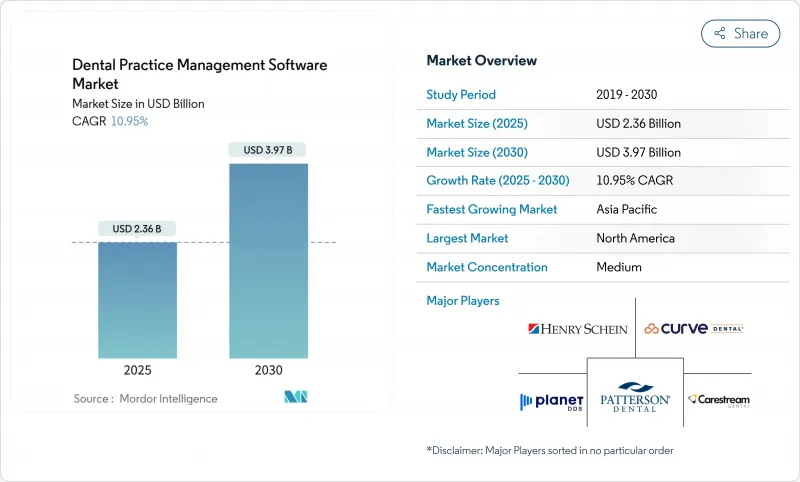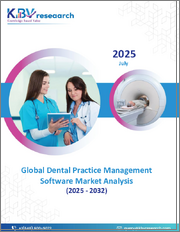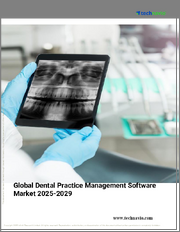
|
시장보고서
상품코드
1842415
치과 진료 관리 소프트웨어 : 시장 점유율 분석, 산업 동향 및 통계, 성장 예측(2025-2030년)Dental Practice Management Software - Market Share Analysis, Industry Trends & Statistics, Growth Forecasts (2025 - 2030) |
||||||
치과 진료 관리 소프트웨어 시장은 2025년에 23억 6,000만 달러로 평가되고, 2030년에는 39억 7,000만 달러로 확대되어 CAGR 10.95%를 나타낼 것으로 예측되고 있습니다.

디지털화 가속화, 클라우드 컴퓨팅 채택, 인공지능의 급속한 보급으로 기존의 워크플로 도구는 통합된 진료 인텔리전스 허브로 변모하고 있습니다. 클라우드를 신속하게 도입한 기업에서는 생산성이 2자리 향상되었다고 보고되고 있으며, AI를 활용한 진단으로 의자 사이드 의사결정 시간이 단축되어 증례 수용률이 향상되고 있습니다. 치과 의료 서비스 기관(DSO) 간의 통합으로 구매력은 엔터프라이즈 규모 플랫폼으로 이동하고 있으며, 전자 청구에 대한 정부의 인센티브는 수익주기 자동화를 계속 가속화하고 있습니다. 동시에 2025년에 제안된 HIPAA 보안 규칙 업데이트와 같은 데이터 보호 규칙의 엄격화로 각 공급업체의 규정 준수 막대가 상승하고 있습니다.
세계의 치과 진료 관리 소프트웨어 시장 동향 및 인사이트
구강 질환의 세계적인 부담 증가가 예방·수리 서비스량을 견인
우식과 치주질환의 만연은 환자의 방문을 증가시키고 원활한 의자 측면 경험에 대한 기대를 높입니다. 더 많은 사례 수에 직면한 치과 진료소에서는 의료 제공업체의 캘린더를 최적화하고, 체크인을 간소화하고, 수익주기의 회전을 단축하는 자동화가 점점 더 진행되고 있습니다. 대규모 DSO는 현재 규칙 기반 스케줄링 엔진을 채택하고 관리자의 키 입력을 줄이고 직원의 능력을 임상 업무에 충당하고 있습니다. AI 트리아지와 리콜 프롬프트를 포함하는 벤더는 예방 중시의 케어 모델에 필수적인 파트너로 자리매김하고 있습니다.
치과에서 디지털 차트와 상호 운용성 표준 채택 확대
USCDI v4를 지원하는 국가 조정 관실의 2024년 규칙은 치과 데이터 교환을 위한 명확한 기술 가드 레일을 설정합니다. 클라우드 벤더는 치과 소견을 의료 EHR의 어휘에 매핑하는 API로 대응하며 양방향 소개 및 통합 환자 포털을 가능하게 합니다. 클리닉이 레거시 플랫폼을 교체할 때 상호 운용성은 라이선스 비용보다 우선하며 개방형 표준 준수를 홍보하는 공급업체는 특히 의과와 치과의 데이터 융합을 요구하는 여러 진료과 센터에서 보다 신속하게 계약을 체결하고 있습니다.
지역 간 데이터 프라이버시, 사이버 보안 및 규정 준수의 복잡성
2025년 HIPAA 제안에서는 자산 재고, 네트워크 매핑 및 교육 강화가 의무화되었습니다. SOC 2-Type II 자격을 갖춘 공급업체는 감사에 대한 불안을 완화하기 위해 턴키 컴플라이언스 대시보드를 제공하지만, 보안에 대한 깊은 전문 지식이 없는 소규모 공급업체는 인증 취득 비용 증가에 직면하고 있습니다.
보고서에서 분석된 기타 성장 촉진요인 및 억제요인
- 클라우드 기반 SaaS 모델 확대로 IT 초기 비용 절감
- PM 소프트웨어와 이미징, CAD/CAM, 체어사이드 시스템의 통합
- 치과 IT에서 표준화 된 임상 코딩과 워크 플로우의 조화의 부족
부문 분석
클라우드 플랫폼은 14.21%의 연평균 복합 성장률(CAGR)을 나타내 가장 높은 성장 궤도를 만들어냈지만, 2024년에는 On-Premise 배포가 45.23%의 최대 수익 슬라이스를 유지했습니다. 클리닉은 마찰없는 업그레이드와 원격 가동 시간 모니터링을 결정적인 이점으로 꼽습니다. 치과 진료 관리 소프트웨어 시장 규모는 탄력적인 컴퓨팅 능력을 필요로 하는 AI 모듈의 배포에 힘입어 2027년까지 On-Premise 수익을 초과할 것으로 예측됩니다. 보안에 중점을 둔 조직에서도 오프사이트 백업의 의무를 해결하기 위해 매일 밤 암호화된 데이터를 클라우드에 동기화하는 하이브리드 모델의 채택이 증가하고 있습니다.
기존의 서버 기반 공급업체는 코드베이스를 마이크로서비스로 재작성하고 있지만 아키텍처 오버홀에는 시간이 오래 걸립니다. 구독 업데이트가 가까워짐에 따라 많은 클리닉이 하드웨어 업데이트를 서두르고 워크로드를 브라우저 기반 콘솔로 마이그레이션하도록 선택합니다. 통합 파트너에 따르면 의자 측 이미지 처리 스테이션은 기존 로컬 서버보다 클라우드 차트에 안정적으로 연결하고 파일을 여는 시간을 단축하며 복구 계획 세션 중에 원격 진료를 지원합니다.
구독 계약은 2024년 치과 진료 관리 소프트웨어 시장 점유율의 60.32%를 획득했고 투명성이 높은 월액 가격과 자동 기능 액세스로 앞으로도 계속 상승할 것입니다. 이 모델은 공급업체와 개업 의사 모두에게 현금 흐름을 안정화하고 소프트웨어 지출을 생산 변동에 맞 춥니 다. 공급업체는 현재 지원, 백업 및 사이버 보안 보험을 구독의 계층 구조로 번들로 제공하고 이전에는 옵션이었던 항목을 표준 권리로 효과적으로 변환하고 있습니다.
영구 라이선스는 연결이 간헐적인 지역과 국내 호스팅을 의무화하는 데이터 주권 규칙이 있는 지역을 중심으로 유지됩니다. 그럼에도 불구하고 첨단 유통업체는 SaaS 도입을 선호하고 전환 크레딧을 제공함으로써 전환 부담을 줄일 수 있습니다. 더 많은 DSO가 다년간의 엔터프라이즈 계약을 체결함에 따라 구독의 MRR은 잠재적인 M&A 타겟의 주요 평가 지표가 됩니다.
지역 분석
북미는 2024년 세계 매출의 40.21%를 차지하며 견조한 DSO 통합과 전자송금에 대한 지불측 인센티브에 지지를 받았습니다. 제안된 HIPAA 업데이트를 통해 컴플라이언스 워크플로우를 통합한 소프트웨어에 대한 수요가 증가하고 있으며, 제3자 기관의 감사를 조기에 완료한 공급업체는 프리미엄 가격을 성공적으로 달성했습니다. 캐나다는 미국의 전자화를 반영하지만, 공급업체가 구성할 수 있는 언어 팩으로 대응하는 이중 언어 인터페이스 요구사항에 직면하고 있습니다.
아시아태평양의 CAGR은 15.23%를 나타내 급속한 성장세를 보이며 정부의 e헬스 추진과 중간층의 심미치과에 대한 지출 확대에 지지되고 있습니다. 중국과 인도는 매년 의자의 수를 늘리고 한국과 태국은 국경을 넘어 치료를 요구하는 사람들을 수용하기 위해 다 통화로 인보이스 발행 및 여권 등급 식별 모듈을 요구합니다. 일본은 AI 진단의 선구자로 계속 18%의 치과의사가 이미 수술실에서 머신러닝에 의한 의사 결정 지원을 실시했습니다.
유럽은 엔드 투 엔드 암호화 및 환자 동의에 근거한 로깅을 의무화하는 GDPR(EU 개인정보보호규정)의 엄격한 규칙에 의해 지원되고 안정적인 수요를 유지하고 있습니다. 다국어 네이티브 템플릿과 개방형 표준 인터페이스에 투자하는 공급업체는 독일, 프랑스, 북유럽에서 견인력을 확보하고 있습니다. 중동 및 아프리카는 현재 규모가 작고 민간 투자가 증가하고 있으며, 특히 걸프 협력 회의 국가에서는 클라우드 퍼스트 인프라가있는 그린 필드 오럴 헬스 복합 시설을 건설하고 있습니다. 라틴아메리카의 기세는 브라질에 집중되어 있어 규제 개혁에 의해 전자 처방전이 허가되어 주요 플랫폼 내에서 통합 e-Rx 워크플로우가 해방되었습니다.
기타 혜택 :
- 엑셀 형식 시장 예측(ME) 시트
- 3개월간의 애널리스트 서포트
목차
제1장 서론
- 조사 전제조건과 시장 정의
- 조사 범위
제2장 조사 방법
제3장 주요 요약
제4장 시장 상황
- 시장 개요
- 시장 성장 촉진요인
- 세계의 구강 질환 증가에 의한 예방·수복 서비스량 증가
- 치과에 있어서의 디지털 차트와 상호 운용성 표준의 채용 확대
- 클라우드 기반 SaaS 모델 확대로 초기 IT 비용 절감
- PM 소프트웨어와 이미징, CAD/CAM, 체어사이드 시스템과의 통합
- 전자청구와 수익주기 자동화에 대한 정부와 보험사의 인센티브
- 대규모 멀티 사이트 치과 네트워크와 세계 기업 치과의 출현
- 시장 성장 억제요인
- 지역 간의 데이터 프라이버시, 사이버 보안, 컴플라이언스의 복잡성
- 치과 IT에서 표준화 된 임상 코딩과 워크 플로우의 조화의 부족
- 노인 개업의 워크플로우 변경에 대한 저항과 낮은 디지털 리터러시
- 소규모 독립 개업의 IT 예산 제한 및 ROI 우려
- 기술적 전망
- Five Forces 분석
- 신규 참가업체의 위협
- 구매자의 협상력
- 공급기업의 협상력
- 대체품의 위협
- 경쟁 기업 간 경쟁 관계의 강도
제5장 시장 규모·성장 예측(금액, 달러)
- 배포 모드별
- On-Premise
- 웹 기반
- 클라우드 기반
- 구독 모델별
- 영구 라이선스
- 구독/SaaS
- 기능별
- 환자 커뮤니케이션 및 참여
- 예약 일정관리 및 캘린더
- 청구 및 송장 발행
- 보험 및 청구 관리
- 치료 계획 및 차트 작성
- 영상 및 진단 통합
- 분석 및 비즈니스 인텔리전스
- 진료 규모별
- 단독 진료소(1-2Ops)
- 소규모 그룹 진료(3-9Ops)
- 대규모 그룹 진료소(10Ops 이상)
- 치과 서비스 조직(DSOs)
- 최종 사용자별
- 치과 클리닉
- 병원 및 전문 치과 센터
- 학술 및 연구 기관
- 지역별
- 북미
- 미국
- 캐나다
- 멕시코
- 유럽
- 독일
- 영국
- 프랑스
- 이탈리아
- 스페인
- 기타 유럽
- 아시아태평양
- 중국
- 일본
- 인도
- 한국
- 호주
- 기타 아시아태평양
- 중동 및 아프리카
- GCC
- 남아프리카
- 기타 중동 및 아프리카
- 남미
- 브라질
- 아르헨티나
- 기타 남미
- 북미
제6장 경쟁 구도
- 시장 집중도
- 시장 점유율 분석
- 기업 프로파일
- Henry Schein Inc.(Dentrix)
- Carestream Dental LLC
- Curve Dental Inc.
- Planet DDS Inc.(Denticon)
- Patterson Companies Inc.(Eaglesoft)
- Open Dental Software
- NextGen Healthcare Inc.
- DentiMax LLC
- tab32
- MOGO Inc.
- ABELDent Inc.
- Software of Excellence Intl.
- ClearDent
- ACE Dental Software
- iDentalSoft
- Practice-Web Inc.
- CareStack(Good Methods Global)
- Dovetail Dental Software
- RxNT Inc.
- Exan Software(axiUm)
제7장 시장 기회와 전망
KTH 25.10.28The dental practice management software market is valued at USD 2.36 billion in 2025 and is forecast to expand to USD 3.97 billion by 2030, registering a 10.95% CAGR.

Accelerated digitalization, the embrace of cloud computing, and the rapid diffusion of artificial intelligence are turning conventional workflow tools into integrated practice-intelligence hubs. Early cloud adopters report double-digit productivity gains, while AI-enabled diagnostics shorten chairside decision-making time and lift case-acceptance rates. Consolidation among dental service organizations (DSOs) is shifting purchasing power toward enterprise-scale platforms, and government incentives for electronic claims continue to speed revenue-cycle automation. At the same time, stricter data-protection rules, such as the 2025 proposed update to the HIPAA Security Rule-raise the compliance bar for every vendor.
Global Dental Practice Management Software Market Trends and Insights
Rising Global Burden of Oral Diseases Driving Preventive & Restorative Service Volumes
Escalating prevalence of caries and periodontal disease is inflating patient visits and elevating expectations for seamless chairside experiences. Practices facing heavier caseloads increasingly turn to automation that optimizes provider calendars, streamlines check-in, and shortens revenue-cycle turns. Large DSOs now employ rule-based scheduling engines that cut administrative keystrokes and free staff capacity for clinical tasks. Vendors embedding AI triage and recall prompts position themselves as essential partners to prevention-focused care models.
Growing Adoption of Digital Health Records & Interoperability Standards in Dentistry
The Office of the National Coordinator's 2024 rule endorsing USCDI v4 sets clear technical guardrails for dental data exchange. Cloud vendors have responded with APIs that map dental findings to medical EHR vocabularies, enabling bidirectional referrals and unified patient portals. Interoperability now ranks above license cost when practices replace legacy platforms, and vendors advertising open-standard compliance close contracts faster, especially in multi-specialty centers seeking medical-dental data fusion.
Data-privacy, Cyber-security & Compliance Complexities Across Regions
The 2025 HIPAA proposal mandates asset inventories, network mapping, and heightened training-requirements that weigh heavily on single-site practices with minimal IT support. Vendors with SOC 2-Type II credentials now showcase turnkey compliance dashboards to ease audit anxiety, while smaller suppliers lacking deep security expertise face escalating certification costs.
Other drivers and restraints analyzed in the detailed report include:
- Expansion of Cloud-based SaaS Models Offering Lower Up-front IT Costs
- Integration of PM Software with Imaging, CAD/CAM & Chairside Systems
- Lack of Standardized Clinical Coding and Workflow Harmonization in Dental IT
For complete list of drivers and restraints, kindly check the Table Of Contents.
Segment Analysis
Cloud platforms generated the highest growth trajectory, expanding at a 14.21% CAGR, while on-premises deployments retained the largest 45.23% revenue slice in 2024. Practices cite frictionless upgrades and remote uptime monitoring as decisive benefits. The dental practice management software market size for cloud offerings is forecast to surpass on-premises revenue by 2027, underpinned by the rollout of AI modules that require elastic compute capacity. Even security-conscious organizations increasingly adopt hybrid models that sync encrypted data to the cloud nightly to meet off-site-backup mandates.
Incumbent server-based vendors are rewriting code bases to micro-services, but architectural overhauls take time. As subscription renewals approach, many practices opt to leapfrog hardware refreshes and shift workloads to browser-based consoles. Integration partners report that chairside imaging stations connect more reliably to cloud charting than to legacy local servers, shortening file-open times and supporting tele-consults during restorative planning sessions.
Subscription contracts captured 60.32% dental practice management software market share in 2024 and continue to climb, due to transparent monthly pricing and automatic feature access. The model stabilizes cash flow for both vendors and practitioners, aligning software spend with production swings. Vendors now bundle support, backups, and cybersecurity insurance into subscription tiers, effectively converting formerly optional line items into standard entitlements.
Perpetual licenses persist mainly in geographies with intermittent connectivity or data-sovereignty rules that mandate in-country hosting. Nonetheless, forward-looking distributors prioritize SaaS onboarding, offering migration credits to lighten the switching burden. As more DSOs ink multi-year enterprise agreements, subscription MRR becomes the prime valuation metric for potential M&A targets.
The Dental Practice Management Software Market Report is Segmented by Delivery Mode (On-Premises, and More), Subscription Model (Perpetual License and Subscription / SaaS), Functionality (Patient Communication & Engagement, and More), Practice Size (Solo Practices (1-2 Ops), and More), End User (Dental Clinics, Hospitals, and More), and Geography (North America, and More). The Market Forecasts are Provided in Terms of Value (USD).
Geography Analysis
North America commanded 40.21% of global revenue in 2024, buoyed by robust DSO consolidation and payer incentives for electronic remittances. The proposed HIPAA update heightens demand for software with built-in compliance workflows, and vendors that complete third-party audits early achieve premium price realization. Canada mirrors U.S. digitization but faces bilingual interface requirements that vendors address through configurable language packs.
Asia-Pacific posts a rapid 15.23% CAGR underpinned by government e-health drives and expanding middle-class spending on cosmetic dentistry. China and India escalate chair count each year, while South Korea and Thailand cater to cross-border treatment seekers, requiring multi-currency invoicing and passport-grade identification modules. Japan remains a vanguard for AI diagnostics, where 18% of dentists already run machine-learning decision support at the operatory.
Europe sustains steady demand, anchored by stringent GDPR rules that compel end-to-end encryption and patient-consent logging. Vendors investing in native multilingual templates and open-standard interfaces secure traction across Germany, France, and the Nordic region. The Middle East and Africa, though smaller today, enjoy rising private-sector investment, especially in Gulf Cooperation Council states constructing greenfield oral-health complexes with cloud-first infrastructure. Latin America's momentum concentrates in Brazil, where regulatory reforms now permit electronic prescriptions, unlocking integrated e-Rx workflows within leading platforms.
- Henry Schein Inc. (Dentrix)
- Carestream Dental
- Curve Dental
- Planet DDS Inc. (Denticon)
- Patterson Companies Inc. (Eaglesoft)
- Open Dental Software
- NextGen Healthcare
- DentiMax LLC
- tab32
- MOGO
- ABELDent Inc.
- Software of Excellence Intl.
- ClearDent
- ACE Dental Software
- iDentalSoft
- Practice-Web Inc.
- CareStack (Good Methods Global)
- Dovetail Dental Software
- RxNT Inc.
- Exan Software (axiUm)
Additional Benefits:
- The market estimate (ME) sheet in Excel format
- 3 months of analyst support
TABLE OF CONTENTS
1 Introduction
- 1.1 Study Assumptions & Market Definition
- 1.2 Scope of the Study
2 Research Methodology
3 Executive Summary
4 Market Landscape
- 4.1 Market Overview
- 4.2 Market Drivers
- 4.2.1 Rising Global Burden of Oral Diseases Driving Preventive & Restorative Service Volumes
- 4.2.2 Growing Adoption of Digital Health Records & Interoperability Standards in Dentistry
- 4.2.3 Expansion of Cloud-based SaaS Models Offering Lower Up-front IT Costs
- 4.2.4 Integration of PM Software with Imaging, CAD/CAM & Chairside Systems
- 4.2.5 Government & Insurer Incentives for Electronic Claims & Revenue-Cycle Automation
- 4.2.6 Emergence of Large Multi-site Dental Networks and Corporate Dentistry Worldwide
- 4.3 Market Restraints
- 4.3.1 Data-privacy, Cyber-security & Compliance Complexities Across Regions
- 4.3.2 Lack of Standardized Clinical Coding and Workflow Harmonization in Dental IT
- 4.3.3 Resistance to Workflow Change & Low Digital Literacy Among Aging Practitioners
- 4.3.4 Limited IT Budgets and ROI Concerns Among Small Independent Practices
- 4.4 Technological Outlook
- 4.5 Porter's Five Forces
- 4.5.1 Threat of New Entrants
- 4.5.2 Bargaining Power of Buyers
- 4.5.3 Bargaining Power of Suppliers
- 4.5.4 Threat of Substitute Products & Services
- 4.5.5 Intensity of Competitive Rivalry
5 Market Size & Growth Forecasts (Value, USD)
- 5.1 By Delivery Mode
- 5.1.1 On-premises
- 5.1.2 Web-based
- 5.1.3 Cloud-based
- 5.2 By Subscription Model
- 5.2.1 Perpetual License
- 5.2.2 Subscription / SaaS
- 5.3 By Functionality
- 5.3.1 Patient Communication & Engagement
- 5.3.2 Appointment Scheduling & Calendar
- 5.3.3 Billing & Invoicing
- 5.3.4 Insurance & Claims Management
- 5.3.5 Treatment Planning & Charting
- 5.3.6 Imaging & Diagnostics Integration
- 5.3.7 Analytics & Business Intelligence
- 5.4 By Practice Size
- 5.4.1 Solo Practices (1-2 Ops)
- 5.4.2 Small Group Practices (3-9 Ops)
- 5.4.3 Large Group Practices (10+ Ops)
- 5.4.4 Dental Service Organizations (DSOs)
- 5.5 By End User
- 5.5.1 Dental Clinics
- 5.5.2 Hospitals & Specialty Dental Centers
- 5.5.3 Academic & Research Institutes
- 5.6 Geography
- 5.6.1 North America
- 5.6.1.1 United States
- 5.6.1.2 Canada
- 5.6.1.3 Mexico
- 5.6.2 Europe
- 5.6.2.1 Germany
- 5.6.2.2 United Kingdom
- 5.6.2.3 France
- 5.6.2.4 Italy
- 5.6.2.5 Spain
- 5.6.2.6 Rest of Europe
- 5.6.3 Asia-Pacific
- 5.6.3.1 China
- 5.6.3.2 Japan
- 5.6.3.3 India
- 5.6.3.4 South Korea
- 5.6.3.5 Australia
- 5.6.3.6 Rest of Asia-Pacific
- 5.6.4 Middle East and Africa
- 5.6.4.1 GCC
- 5.6.4.2 South Africa
- 5.6.4.3 Rest of Middle East and Africa
- 5.6.5 South America
- 5.6.5.1 Brazil
- 5.6.5.2 Argentina
- 5.6.5.3 Rest of South America
- 5.6.1 North America
6 Competitive Landscape
- 6.1 Market Concentration
- 6.2 Market Share Analysis
- 6.3 Company Profiles (includes Global level Overview, Market level overview, Core Business Segments, Financials, Headcount, Key Information, Market Rank, Market Share, Products and Services, and analysis of Recent Developments)
- 6.3.1 Henry Schein Inc. (Dentrix)
- 6.3.2 Carestream Dental LLC
- 6.3.3 Curve Dental Inc.
- 6.3.4 Planet DDS Inc. (Denticon)
- 6.3.5 Patterson Companies Inc. (Eaglesoft)
- 6.3.6 Open Dental Software
- 6.3.7 NextGen Healthcare Inc.
- 6.3.8 DentiMax LLC
- 6.3.9 tab32
- 6.3.10 MOGO Inc.
- 6.3.11 ABELDent Inc.
- 6.3.12 Software of Excellence Intl.
- 6.3.13 ClearDent
- 6.3.14 ACE Dental Software
- 6.3.15 iDentalSoft
- 6.3.16 Practice-Web Inc.
- 6.3.17 CareStack (Good Methods Global)
- 6.3.18 Dovetail Dental Software
- 6.3.19 RxNT Inc.
- 6.3.20 Exan Software (axiUm)
7 Market Opportunities & Future Outlook
- 7.1 White-space & Unmet-need Assessment

















